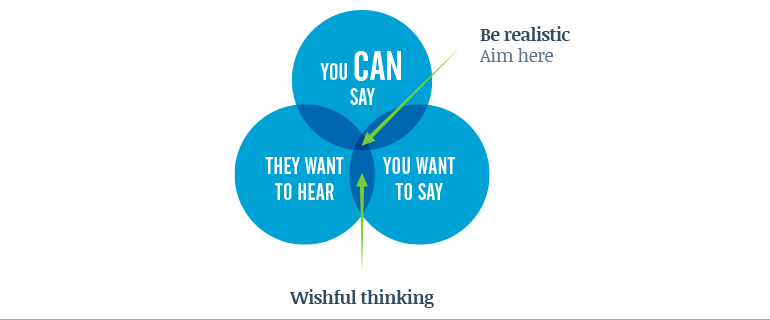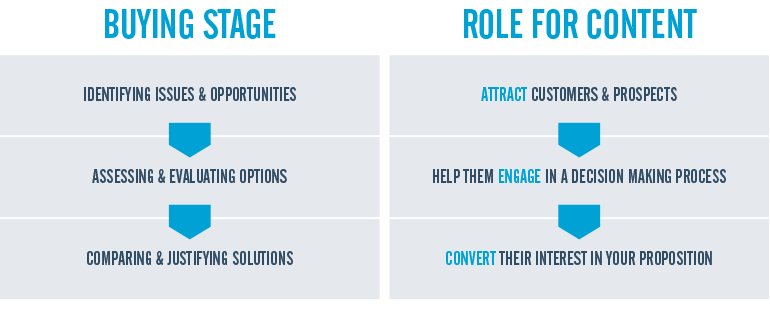Start with the customer, they say. Be customer-centric. Put yourself in your customer’s shoes.
So why are so many of the ‘buyer journeys’ produced by marketing departments and agencies actually vendor journeys? We find that a good way of keeping the focus on the customer is keep the whole thing as simple as possible.
In truth, it’s not just one journey that customers go through on their way to buying your product. Customers go on a journey from ignorance to knowledge. They go from frustration to satisfaction. They go from doubt to vindication.
But sitting round the table at the vendor offices, it’s easy to see it as either a sales process (get to know the customer, empathise, propose solutions, negotiate, close) or a product lifecycle (launch, develop, mature, refine, replace). We prefer the approach taken by IDC’s Kathleen Schaub, who prefers to see it as a series of questions asked by the buyer. Answer the questions and you’ll win their attention, their trust, and ultimately their business.

Why should buyers care about you?
The truth is they don’t care. Unless of course they see value in the content and user experiences you offer them, in which case they will engage. If you set out to help your buyers achieve their goals, you stand a far better chance of achieving yours. Keep this value exchange in mind and don’t lose sight of the fact that your audience’s needs differ at different stages in the decision making process.
But don’t overcomplicate it. The reality is that putting pressure on yourself to create content to address five or six different buying stages adds massively to the complexity involved in addressing multiple product lines, stakeholders and business segments. We like to think we have kept our approach to the “buyer” journey as simple and as pragmatic as possible with just three basic stages – and recommend getting them right before tying yourself in content marketing knots.

The three-stage model
Our view is that prospects have three broad activities that they engage in consciously or otherwise:
1. Identifying issues and opportunities
2. Assessing and evaluating options
3. Justifying solutions
The key to using this kind of buyer journey is to know the questions that your customers or prospects will be asking at each stage – and therefore what you are helping them to do. In this way, we can convert a buyer journey into a framework for what we should be doing for them.
These are our basic three stages – along with a few examples of the questions your customers or prospects may be asking:
Stage 1: Identifying issues and opportunities
Your job is to help them see the opportunity
You will need content to ‘attract’ people to the pain, issue or opportunity your offering addresses, while positioning your business as experts in the field. It’s usually too early to promote a specific product – limit yourself to talking about the generic opportunity. After all, that’s what they want. Focus on thought leadership and content that identifies with audience insights. Ideally you should have a unique perspective on the topic or issue, but at the very least you should state your point of view clearly and avoid the jargon of your competitors.
Also bear in mind that at this stage of the buyer journey, the actual buying decision is a way off. This means the buyer is under less immediate pressure, and able to investigate “what if” scenarios. All you are helping them to do is see the possibilities that are out there. Relax, make it attractive, make it enjoyable.
Buyer questions:
- Are there different – and better – ways of doing what I’m already doing?
- What are other people in my industry/geography/line of business doing?
- What’s new this year, and what could it mean to me?
Stage 2: Assessing and evaluating options
Your job is to help them evaluate
As Peter Drucker famously pointed out, people have more choice these days than ever before, yet they are typically quite unprepared to deal with that choice. The middle part of the buyer journey is therefore becoming more and more painful for buyers, as they try to find a meaningful way to compare and evaluate the options before them.
People have more choice than ever – but are unprepared to deal with it
Your role, as a content marketer, is to try and make it easier. That means providing help with the criteria they have chosen. Give them clarity and objectivity. At this stage you are not selling a single choice, but helping them to understand the choices available to them. Focus on checklists, purchasing guides, specific requirements for each industry (eg compliance) and provide tools to facilitate group decision-making.
Buyer questions:
- What criteria should I be using?
- What do my friends/peers/influencers think?
- How can I compare them – or try them out?
Stage 3: Justifying solutions
Your job is to help them choose with confidence
Now it is time to talk about why the audience should choose you. Help them compare (using your decision-making criteria), provide them with the information they need to be able to assess your solution. Focus on making it easy: product datasheets, value proposition documents and portfolio-related collateral. Some of the most powerful content we’ve seen has been the internal sell-sheets and competitive playbooks that are produced as sales enablement tools – why not let your website and content do the same job for you?
Buyer questions:
- Can I afford it? Do I actually need it now – or later?
- How will it fit with my existing infrastructure/business/team?
- What happened to others who did it?
- How long until I see ROI?
Prospects should neatly progress from one stage to another – but the real world doesn’t work like that
Buyers aren’t normal
Buying journeys have an implicit premise that prospects should neatly progress from one stage to another – but the real world doesn’t work like that, so you need to keep some flexibility in mind as you integrate content engagement with qualification calls and ultimately hand over to sales.
Another advantage of keeping it simple is that you know you’ll get it right. Once you’ve got your content marketing machine up and running, and delivering results you can start adding complexity – but not at the outset. We like to think that our clients can use their buyer journey planning not just to identify which whitepapers to write and what videos to produce, but also to defend how they are spending their budget. Solid logic, simple steps, sensible decisions – and a high degree of certainty that it’s going to work.


